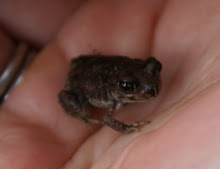
One great way to get involved with the nature around you is to invest in a few field guides. They come in a variety of sizes, ranging from pocket pamphlets to hefty bookshelf adornments. Whatever you opt for, most are easy to use, and its amazing how quickly they change the way you walk in the woods.
Once I got a few guides, I didn't just glance over the flowers, trees, and birds. I stopped, payed attention to detail, and looked them up. Several years ago I moved halfway across the country, and while much of the flora and fauna stayed the same, there were plenty of new things that I didn't recognize. I grew up in the Northeast, and was pretty familiar with that area, but here in the Midwest I am continually discovering new and exciting things to look up. Just the other day I was out for a walk and noticed some beautiful spring flowers that grew close to the ground. The top half of each flower was white, and the bottom half light blue. I hadn't brought my wildflower book with me, so when I got home I raced to the bookshelf and identified them as Blue-eyed Marys (in photo at top). That was a new one for me: I knew Black-eyed Susans, but I'd never even heard of these!
Silly? Maybe, but how fun to know just one more thing about the world around me. Just imagine what that kind of enthusiasm can do for kids! Instead of having to answer every question with, "I don't know..." when your child asks you to identify something, with a field guide you can say, "Let's look it up!"
My favorite broad regional field guides are put out by the National Audubon Society, but they are available at most major bookstores. I find them informative without being overwhelming, and they have great pictures with intuitive organization that makes it easy to find what you're looking for.
If you really want to get into things, though, I recommend both the Audubon Society guides and more localized guides as well. Most states have local field guides: I especially like those of Stan Tekiela. They are an excellent size to take hiking, and help narrow things down to the specimens that you are most likely to find in your area. His photographs are excellent, and his personal notes are quite helpful.
Wednesday, May 7, 2008
A field guide to field guides
Labels:
field guides,
flowers,
nature
Subscribe to:
Post Comments (Atom)



No comments:
Post a Comment